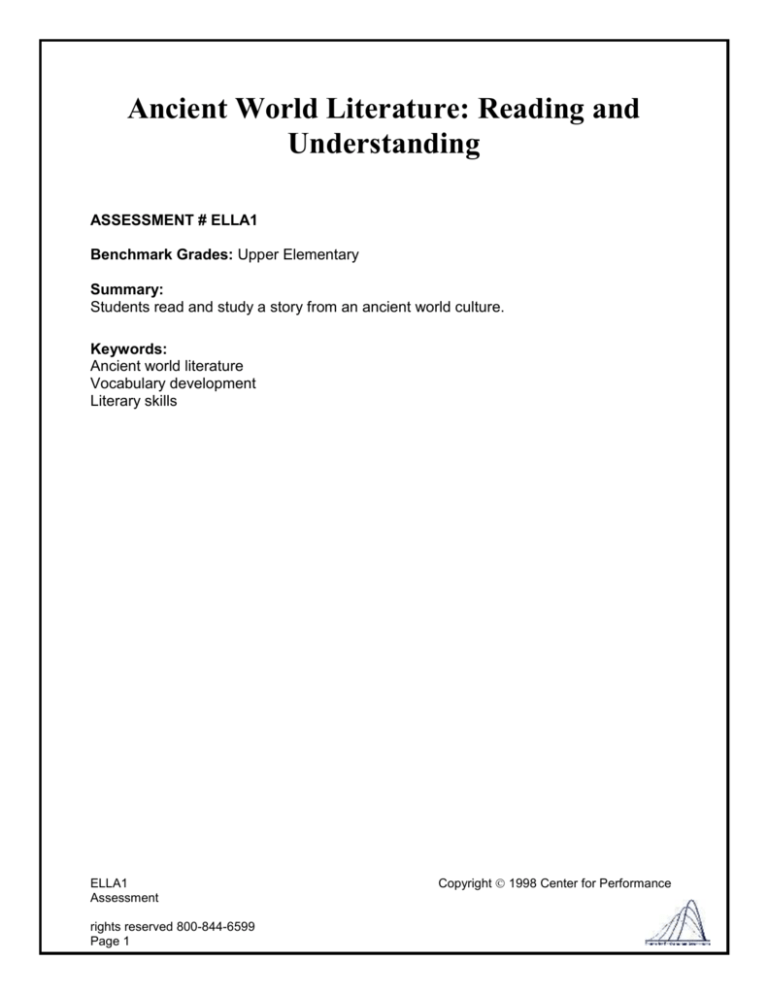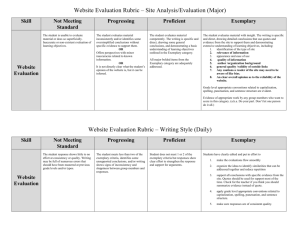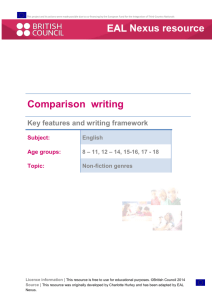
Ancient World Literature: Reading and
Understanding
ASSESSMENT # ELLA1
Benchmark Grades: Upper Elementary
Summary:
Students read and study a story from an ancient world culture.
Keywords:
Ancient world literature
Vocabulary development
Literary skills
ELLA1
Assessment
Copyright 1998 Center for Performance
All
rights reserved 800-844-6599
Page 1
Ancient World Literature: Reading and
Understanding
ASSESSMENT # ELLA1
Information for the Teacher
Task Description
This assessment asks students to read and understand a story that is not only from a
different culture, but from a different time period as well.
You should provide examples of “the moral of the story” from literature with which the
students are already familiar.
Required Materials
You may choose an appropriate story from your list of world literature, but it should have
the following characteristics:
The story should be from a non-United States culture.
The story should be from the ancient time period with another more modern version
for the second part of the assessment.
The story should contain several episodes or events to facilitate the construction of
an outline.
The story should have a moral point or lesson.
ELLA1
Assessment
Copyright 1998 Center for Performance
All
rights reserved 800-844-6599
Page 2
Ancient World Literature: Reading and
Understanding
Assessment Introduction: Here is what you will do...
Reading about other places and times gives you a glimpse of what it was like to
live another life. It also helps you to understand the differences and similarities
among people over time and across the globe. Can you think of other great things
that come from reading about other times and places?
You will be given a story to read that was written a long time ago. Read the story
carefully. Next, read all four tasks of this assessment. Then read your story
again as you begin work.
ELLA1
Assessment
Copyright 1998 Center for Performance
All
rights reserved 800-844-6599
Page 3
Task 1: Think about the vocabulary
Language changes over time. One place to investigate is to analyze the vocabulary that
an author uses.
Make a list of all of the words in the story that are unfamiliar to you. Also list those
words that you do know, but are unusual words that you do not use every day.
Then, for each of the words, look up the definition in the dictionary to learn what it
means. Write a sentence that uses the word correctly and shows its meaning.
ELLA1
Assessment
Copyright 1998 Center for Performance
All
rights reserved 800-844-6599
Page 4
Scoring Guide - Task 1
4
3
2
1
Exemplary
The student identifies several words that are either new or unusual.
Each word is defined.
A sentence is written using each word. The words are used correctly.
The sentences are grammatically correct.
More advanced work is included. For example, the student uses two or more
vocabulary words correctly in one sentence. More than one sentence is
written for each word. The sentences relate to each other.
Proficient
The student identifies several words that are either new or unusual.
Each word is defined.
A sentence is written using each word. The words are used correctly.
The sentences are grammatically correct.
Progressing
The student uses at least one new vocabulary word correctly in a sentence. He or
she attempts to write sentences for other words.
Uses at least one unusual word in a sentence.
The use of the words may not be correct. The sentences may have grammar and
spelling errors.
More work is needed.
Not meeting the standard(s)
The response does not meet one or more requirements of a progressing score.
The task should be repeated.
ELLA1
Assessment
Copyright 1998 Center for Performance
All
rights reserved 800-844-6599
Page 5
Task 2: Outline the story
Make an outline of the story. Include a description of the elements of the story such as:
Setting
Major characters
Major plot problems
Solution
Other important events
You may make your outline in a paragraph or summary form. You could also write
your own translation of the story by imagining how the story would be if it happened
today in the United States rather than a long time ago. How would the story be
different?
ELLA1
Assessment
Copyright 1998 Center for Performance
All
rights reserved 800-844-6599
Page 6
Scoring Guide - Task 2
4
3
2
1
Exemplary
An outline of the story is written in outline form or paragraph form.
The outline is so clear that the reader or viewer would not have to ask questions to
understand the story.
The outline addresses all of the parts of the task, including the setting, the main
characters, and the problem and solution.
All of this is correct and is from the story.
An exemplary performance includes additional work that was not required in
the task. For example, the student may choose to present the outline in more
than one way, or the organization of the outline is exceptional.
Proficient
An outline of the story is written in outline or paragraph form.
The outline is so clear that the reader or viewer would not have to ask questions to
understand the story.
The outline addresses all of the parts of the task, including the setting, the main
characters, and the problem and solution.
All of this is correct and is from the story.
Progressing
An outline of the story is written in outline or paragraph form.
There are parts that are missing or unclear so that the reader or the viewer has to
ask questions to understand the story.
Not meeting the standard(s)
An outline is attempted in outline or paragraph form.
The outline is missing parts or is so unclear that the reader or the viewer can not
understand it.
The story should be reread and the task should be repeated.
ELLA1
Assessment
Copyright 1998 Center for Performance
All
rights reserved 800-844-6599
Page 7
Task 3: What is the point of the story?
There is a meaning or point to every story. What is the point of this story? Does it
have a moral or a lesson to teach? Describe the moral in as much detail as you can.
For example, use more than just “You should be good” to describe the meaning of the
story.
Is this still an important moral or lesson today? How does this lesson still affect people
your age during modern times?
Use examples from the story and use as much detail as you can.
ELLA1
Assessment
Copyright 1998 Center for Performance
All
rights reserved 800-844-6599
Page 8
Scoring Guide - Task 3
4
3
2
1
Exemplary
The moral or the lesson of the story is given.
It includes details and examples from the story.
It is clearly written.
The exemplary response includes additional work or information. For example,
the student may include a comparison of the lesson of this story to others that
have been previously read, or may talk about how the moral or lesson was
viewed in ancient times compared to the modern day.
Proficient
The moral or the lesson of the story is given.
It includes details and examples from the story.
It is clearly written.
Progressing
The moral of the lesson or story is given, but it lacks the detail and use of examples
required in the task.
Revision is necessary to meet the criteria for proficiency.
Not meeting the standard(s)
An attempt is made to tell the moral or lesson of the story, but it may not be accurate
because the story was not read fully or because it was not understood.
The story should be reread and the task should be repeated.
ELLA1
Assessment
Copyright 1998 Center for Performance
All
rights reserved 800-844-6599
Page 9
Task 4: A different version of the same tale
Now read another version of the same story, perhaps a more modern version.
Compare and contrast the two stories. Make sure to find at least five similarities or
differences in the two stories.
How do you know which is the more modern? Give three examples of how you can
tell. It may be something simple like the clothes the characters wear.
ELLA1
Assessment
Copyright 1998 Center for Performance
All
rights reserved 800-844-6599
Page 10
Scoring Guide - Task 4
4
3
2
1
Exemplary
A second version of the story is read.
The old and new versions of the story are compared with at least five examples of
similarities or differences identified.
At least three examples of comparison for the more modern version are given with
details and references made to the text.
An exemplary response requires more work that was not required in the task.
For example, a more in depth comparisons of the five similarities and
differences or more than three examples of comparisons for the modern text.
Proficient
A second version of the story is read.
The old and new versions of the story are compared with at least five examples of
similarities or differences identified.
At least three examples of comparison for the more modern version are given with
details and references made to the text.
Progressing
A second version of the story is read.
The old and new versions of the story are compared and one example of similarities
or differences is identified.
At least one example of comparison for the more modern version is given with
details and references made to the text.
Not meeting the standard(s)
The story should be reread and compared again because no comparisons were
identified or the student was not able to complete the task without assistance.
ELLA1
Assessment
Copyright 1998 Center for Performance
All
rights reserved 800-844-6599
Page 11








